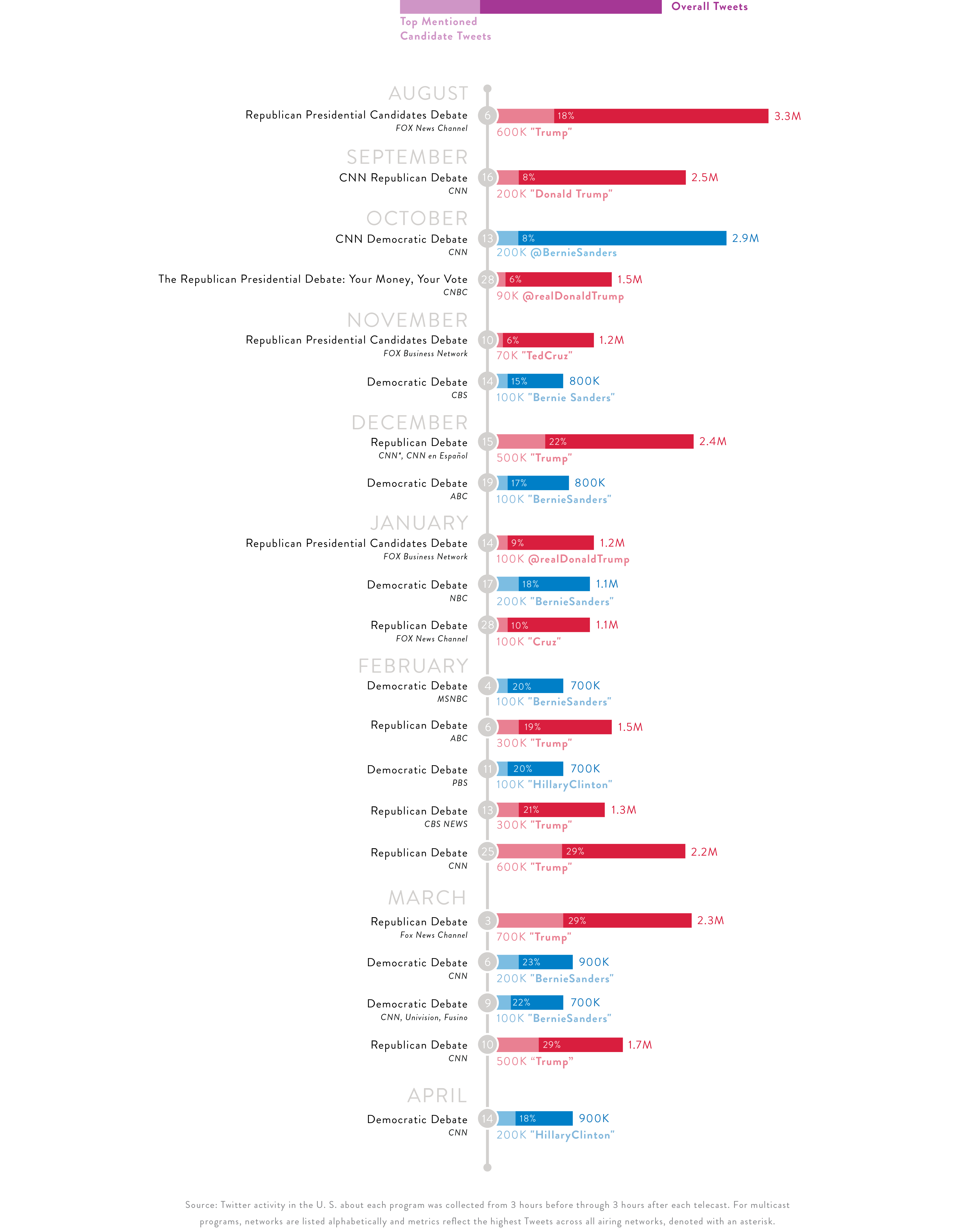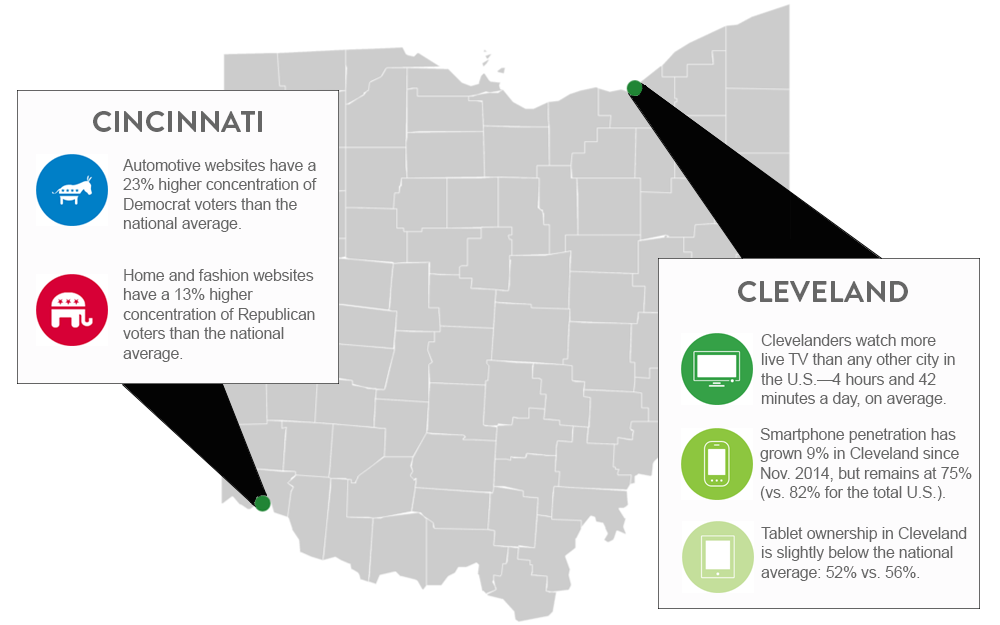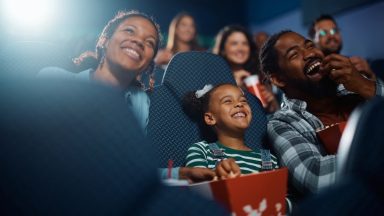Election Central

Nielsen’s hub for the data behind the 2016 presidential election
On Nov. 8, 2016, Americans will vote in the 58th U.S. presidential election. This year, we’re using our Election Central to showcase the data behind the campaigns, the methods candidates, parties and political action committees (PACs) use to reach voters and the voters themselves—all based on insights from Nielsen Political Solutions. We’ll be updating data through Election Day, so check back regularly!
For more information about Nielsen Political Solutions, contact us.
Reaching Pivotal Voter Segments in the 2016 Election
This webinar examines several of those critical voter segments—single white females, Millennial Hispanics, African-Americans and noncollegiate white males—in an effort to assist campaigns, consultants and agencies in understanding more about who they are, what issues they deem most important and which media strategies will reach them before they cast their ballots at the polls.
Campaigns

Campaigns mean big money. In the 2012 presidential election, winner Barack Obama spent more than $700 million campaigning, and this number is expected to climb event higher for the 2016 presidential canidates. But as we head toward Election Day 2016, candidates on both sides of the aisle are using methods beyong just paid advertising—from social media to books and music—to build awareness around their efforts and messages. That said, paid advertising is still a key component of political organizations efforts to connect with voters.
Earned Media

Debates and Social Media
Debates can be key battlegrounds for both parties both before the primaries and leading up the final vote. These forums provide candidates crucial (and free) chance to speak to voters—though they don’t always cast candidates in their desired light.
With the growth of digital, candidates taking the stage can also earn voters’ attention on small screens through social media during debates. A recent study found that TV events can help drive earned media on Twitter for brands. With that in mind, we’ve measured the overall volume of Tweets and identifying the top mentioned candidate on Twitter during each debate this election season.

Leading up to the primaries, the Republican debates saw the greatest volume of Tweets. And the eventual nominee, Donald Trump, was the most popular candidate for all but two Republican debates before the Iowa caucus—including the debate he missed on Jan. 28, 2016. On the Democratic side, Senator Bernie Sanders was the top mentioned candidate during every debate leading up to February.
Just in time for the presidential and vice presidential debates, Nielsen announced the launch of Social Content Ratings this summer, which added Facebook data into Nielsen’s social TV measurement to become the most comprehensive measure of program-related social media activity across both Facebook and Twitter.
The first debate, on Sept. 26, 2016, was the was the most watched debate in history, surpassing the 2012 debate between Obama and Romney and the historic 1980 debate between Jimmy Carter and Ronald Reagan. And this debate had the highest social engagement with 83 million total interactions on Facebook and Twitter. By candidate, Trump consistently saw higher mentions on Twitter.


Books
Not all aspects of the 2016 campaigns are digital. Candidates have also used old school ways to reach voters—publishing books to tell their story. As we get closer to November, we wondered how the Democratic and Republican parties’ nominated candidates’ book sales stack up. Donald Trump’s 2016 book sales (as of Aug. 14, 2016) have significantly outpaced those of Hilary Clinton. However, Clinton’s book sales have long-term value, with her four books generating more sales since their release than Trump’s nine books.
No matter who wins the race, both candidates could continue to see a boost to their book sales. Several candidates who have dropped out of this election’s race, including Ben Carson and Bernie Sanders, have seen their 2016 book sales rank higher than some books by the nominated candidates.

Music
While not always written specifically for a campaign, music has historically played a key role in energizing voters—from “God Save Great Washington,” a parody of “God Save the King” written for our first president, to the use of Stevie Wonder’s “Signed, Sealed, Delivered I’m Yours” in Barack Obama’s campaign.
Music can help campaigns reach the masses. But research from Nielsen’s Music 360 2016 report shows that how Americans spend on music and entertainment may vary according to how you vote. For example, Democrates outspend Republicans on live music overall. When we look at genres, Independents are the most likely to listen to classic rock.
It should come as no surprise that this year’s campaigns have been using music to their advantage. Katy Perry—one of the top five music personalities among adults age 18-34—appeared on stage at the Democratic National Convention.
Paid media

advertising
Despite the other ways this year’s candidates are earning attention for their campaigns, advertising is still one of the top ways parties and candidates can share their messages directly with voters—and upwards of 65% of candidates’ funds are spent on media. But in today’s fragmented media landscape, where are political ads being placed?
When it comes to traditional media, the majority of ad units are bought for TV. However, radio has seen the biggest growth in the number of ads this political season compared to the last presidential race.
REach
From debates and social media to traditional advertising, all campaigns aim to expand voters’ awareness of their candidates and drive these people to head to the polls on Election Day. But how can campaigns know if—and where—their messages are reaching voters and resonating? And can they ensure voters are aware—and like—their candidates?


TV
It should be no surprise that TV is the most popular platform for political advertising. According to our latest Total Audience report, Americans spend more time watching live TV (4 hours and 9 minutes a day) than consuming content through radio, smartphones, tablets or PCs.
To help understand how voters are watching TV, we’ve created voter ratings, which use voter segments from Experian Marketing Services’ Simmons National Consumer Study and are part of Nielsen Political Solutions. By comparing our voter ratings to our P18+ ratings, we’re able to identify how TV programs reach different voter groups with precision and scale. Based on these insights, local TV shows can be identified by station to efficiently deliver specific voter segments.
So what are voters watching? We recently studied the media habits of two voter groups—Conservative Democrats and Mild Republicans. Both of these demographics tend to identify as liberal and conservative depending on the issue, making them more “persuadable” and potential voters for campaigns to win over. It turns out that these different voter groups watch different television programming depending on their location. However, some genere’s overlap. For example, News is popular with both groups in almost every location.
Our voter rating index scores indicate how much more likely these voter groups are to view show genres than the general person 30 and older. For instance, in Denver, Conservative Democrats 30 and older are about 3.5x more likely to view the game show genre than the average person 30-plus in the Mile High City.

radio
While Americans spend the most time with TV, radio reaches the most people in the U.S.—93% of Americans tune in to radio each week. But how are voters using this medium? We looked at each of Experian’s major voter segments to how these groups break out across the top five radio formats nationally. Not surprisingly, News/Talk has the greatest amount of people who have already “made up their minds” whether Republican or Democrat. Meanwhile, Urban Adult Contemporary (AC) and Contemporary Hits Radio (CHR) are great for the “register to vote initiative.” And Republican and Demoracte listenership levels are almost equal for Country.
But it’s also important to remember that radio’s local approach to programming means that local stations attract different voter types in each market. First, it’s imporant to understand the percentage of each group tuning in to radio overall. In Indianapolis, most polical groups tune in on-par with the country nationally. However, some groups are less likely to listen to radio. But finding the top station for each voter group can help political organizations reach specific voter groups. For example, in Philadelphia, top stations reached about a quarter or more of some of the top voter groups.

Digital
As digital takes over more and more of people’s time, it’s also a growing piece of the advertising pie. According to a recent study by Borrell Associates, $159 million was spent online for political campaigns in 2012, and by 2016 election, that figure is estimated to reach $995 million—a growth of 500%. In a recent study, the good news for campaigns is that device ownership is on the rise for all voters. But how are they using digital? Social media use is highest across all voter groups.
Voters
Campaigns are eager to reach voters, but with Election Day getting ever closer, each candidate needs to focus on reaching the voters most likely to vote for them, as well as those who can still be swayed. With that in mind, we’re diving deep into key American voter groups based on affiliation, age, ethnicity/culture and location.

affiliation
What does the voter landscape look like in the U.S. today? While one candidate will be selected to run on the Democrat ticket and another for the Republican ticket, Americans are not as clearly defined by parties but instead fall on a scale—from the most liberal Super Democrats to the Ultra Conservatives and everything in between.
Depending on the issue, different groups may lean more liberal or conservative. For example, in the voter segments from Experian Marketing Services’ Simmons National Consumer Study, while Conservative Democrats are liberal toward environmental and international issues, they lean conservative on abortion. Meanwhile, Mild Republicans are conservative about international issues, but on the fence on environmental and health care issues and liberal about the legalization of marijuana and abortion.
Important for this year’s race, 30%-40% of Americans identify themselves as Independents, a 25-year record high. That means it’s ever more important for candidates to find and connect with this influential voter group. But it’s a diverse group: 18% are Millennials, 29% are minorities and 52% are women.
Age
Millennials comprise a quarter of the U.S. population, and nearly three-quarters (73%) say they have some affiliation with a political party. While these voters present a tremendous opportunity for all campaigns, they’re not always easy to reach. They’re more multicultural and educated than older generations. But music and social media may be two areas where candidates can connect with these young voters.
Still, while young voters tend to be early adopters of new technologies and social media, they are also heavily engaged with traditional media, including TV and radio. In cities such as Charlotte, Pittsburgh and Miami, which are in battleground states, young voters are up to 76% more likely than the average 18-34 adult to watch local news.
Ethnicity/Culture
Millennials are more multicultural than older generations. In fact, nearly 40% of this demographic identifies as multicultural. Nielsen’s Local Watch Report looked at registered Millennial voters in their district and what their marital status was, differentiating by race/ethnicity. The findings showed that single African-Americans—be it men or women—made up 81% of registered voters 18-34 in their district. That is 11 percentage points higher than registered Hispanic singles and nearly 20 percentage points higher than White singles 18-34!
But while the media tends to shine a spotlight on young, digitally savvy Millennials, the potential Boomer (50-64) and Greatest Generation (65+) voters could have on this year’s election is also notable—particularly among Hispanics. Older Latinos have the potential to be decisive swing votes in many upcoming local and state elections: 60% of Latinos 65+ voted in the 2012 presidential election, which was higher than all other age groups for Latino voters. Addressing these voters’ top issues and embracing mobile could be key to earning their votes.
Location
Location can play a big role in how different segments use different types of media. For instance, according to the January 2016 Local Watch Report, Washington, D.C., Seattle and Miami top the list of markets with the highest percentage who watched mobile video in the past month at 39%, 38% and 36%, respectively. In that same report the markets with the least amount of traditional live TV viewing are in San Francisco and Los Angeles, which can help serve as a directional harbinger for campaigns looking to reach voters but with choices to make in where they are actually placing their ad-buy dollars.
Spotlight: Ohio
With that in mind, we’re diving deep into the media habits and voter affliations of consumers in some of the states that could play key roles this political season. First up, Ohio. Nielsen Scarborough data shows a whopping 86% of voters in this swing state say they always vote in presidential elections, significantly more than in state and local elections. But party affiliation varies by age. Older voters are much more likely to report being affiliated with a specific party than younger voters, making those 18-34 key voters for candidates to woo over the next few months.
The good news is younger voters may be easier to find. Ohioans 18-34 are significantly more liklely than those 50+ to have a variety of digital devices. But campaigns shouldn’t ignore traditional media, espcially radio. While Ohioans 18-34 spend less time listening to radio than any other age group, radio also reaches more of these young listeners.
Finally, we looked at specific media habits in two of Ohio’s key markets. In Cleveland, Democrats and Republicans are found in higher concentration on different types of websites. Meanwhile, Clevelanders favor traditional media, watching the most live TV of any city in the country. Still, smartphone ownership is growing.




